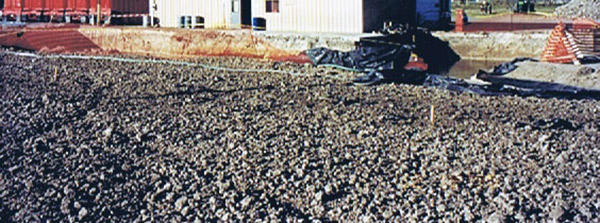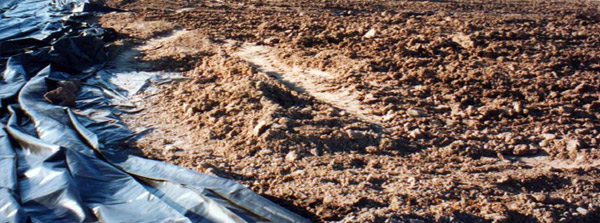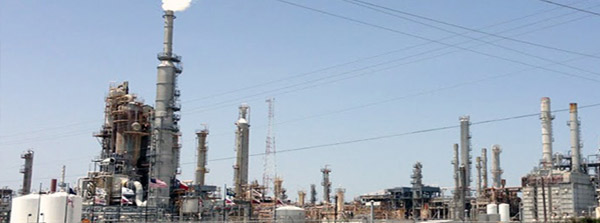Piranha Case Studies
Case Study 1
Problem – Diesel and Oil Contaminated Soil.
Products used – Piranha
Site Location and Description – Military Air Station in South Texas
Approximately 1,500 m3 of soil contaminated by a mixture of diesel fuel and oil. The soil was excavated and moved to a lined treatment pad.
Contaminants Treated – diesel fuel and oil
Geology – Caliche and Sandy Soil
Starting Levels – TPH levels ranged from 3,500 to 8,000 ppm. A sample composite was prepared by collecting 30 samples from randomly selected points.
Cleanup Standards – per the State of Texas (TCEQ)
TPH (total petroleum hydrocarbons) – less than 50 ppm.
BTEX (benzene, toluene, ethylbenzene, and xylenes) – non detect
MTBE (methyl tertiary-butyl ether) – non detect
Treatment Method – in situ
The soil spread evenly over a 170 x 30 meter area on a black plastic liner. The product was applied to the soil. The soil was watered and tilled.
The site was tilled two more times over a 6 week treatment period and watered, as per recommendations to promote rapid biodegradation of the hydrocarbons present in the soil.
After sixty days samples were collected and analyzed. There were no reportable levels of either TPH or BTEX/MTBE found by either third party laboratory in any of the samples submitted for analysis. While the reporting limits for the two laboratories varied slightly, both laboratories reported TPH at or below 50 mg/Kg and BTEX/MTBE – non detect.
This met the initial criteria set by the project manager and The State of Texas (TCEQ). The project was deemed to have been successfully completed, and no further treatment of the soil was recommended.
Actual Time Frame – 60 days
Third party testing standards used – TCEQ method TX1005 for TPH analysis. — USEPA method 8260 or — USEPA method 8021B for BTEX/MTBE (benzene, toluene, ethylbenzene, xylenes and methyl t-butyl ether)
Goals
- Reduction of TPH and BTEX/MTBE levels in the soil.
- To clean the soil per State of Texas standards
- TPH – less than 50ppm BTEX/MTBE – non detect
- Complete project within 90 days
Results Achieved
- 99.9% reduction of diesel fuel and oil in the soil.
- Achieved State of Texas cleanup levels
- TPH – less than 50ppm
- BTEX/MTBE – non detect
- Finished 30% ahead of schedule.
- Eliminated cradle to grave liability.
Case Study 2
Problem – Refined Oil and Crude Oil Spill at a Refinery.
Products used – Piranha
Site Location and Description – Refinery in South Texas
The refinery had a number of spills in several different areas within their facility. The hydrocarbon contaminated soil was a mix of refined and crude oils. The soil was excavated, collected and consolidated into one area, a bio-pad. The total amount of soil treated in the bio-pad was approximately 100 cubic yards.
Contaminants Treated – Refinery petroleum hydrocarbon waste and crude oils.
Geology – Caliche and Sandy Soil
Starting Levels – TPH levels from 8,000 to over 14,000 ppm. A sample composite was prepared in the treated area by collecting 10 samples from randomly selected points.
Cleanup Standards – per the State of Texas (TCEQ)
TPH (total petroleum hydrocarbons) – less than 50 ppm.
BTEX (benzene,toluene,ethylbenzene,& xylenes) – non detect
MTBE (methyl tertiary-butyl ether) – non detect
Treatment Method – in situ
The soil was treated once with the Piranha mixture and tilled. Water was added at approximately 10%.
At the end of the treatment period samples were collected and analyzed by a third party laboratory. Based on these analytical results the detected concentrations were below the TCEQ Class 1 Residential 30-acre soil limits. The soil was successfully treated to meet the requirements set forth by the project manager and the State of Texas (TCEQ) in the Texas Risk Reduction Program (TRRP) Class 1 Residential standards for soil.
The project was deemed to have been successfully completed, and no further treatment of the soil was recommended.
Actual Time Frame – 60 days
Third party testing standards used – TCEQ method TX1005 for TPH analysis. — USEPA method 8260 or — USEPA method 8021B for BTEX/MTBE (benzene, toluene, ethylbenzene, xylenes and methyl t-butyl ether)
Goals
- To reduce the TPH and BTEX/MTBE levels in the soil.
- To clean the soil per State of Texas – TCEQ standards
- TPH – less than 50ppm
- BTEX/MTBE – non detect
- To complete project within 80 days
Results Achieved
- 99.9% reduction of refinery waste oils and crude oils.
- Achieved State of Texas requirements
- TPH – less than 50ppm
- BTEX/MTBE -non detect
- Finished 25% ahead of schedule.
- Eliminated cradle to grave liability.
Case Study3
Problem – Light Cycle Oil (LCO) and Gas Oil Spill around storage tanks.
Site Location and Description – Refining Facility of major oil company
The facility had a spill in the areas surrounding two tanks (A and B), the spill contained light cycle oil (LCO) and gas oil.
Contaminants Treated – Gas oil and light cycle oil fuel and oil
Geology – Caliche and Sandy Soil
Starting Levels – TPH levels ranged from 26 to over 1,300 ppm. 13 samples were collected in the treated area. 5 samples from around Tank A and 8 samples from around Tank B in randomly selected points.
Cleanup Standards – per the State of Texas (TCEQ)
TPH (total petroleum hydrocarbons) – less than 50 ppm.
Treatment Method – in situ
The product was applied around Tank B, and in an open area between Tanks A and B. During the treatment free gas oil was found in the area between the tanks. As a result, treatment around Tank A was temporarily suspended in order to discuss and review treatment options. Some of the area around Tank B was not accessible due to maintenance. The decision was made to come back after the maintenance work was finished and to complete the treatment of Tanks A and B. Further treatment involved an additional application around Tank A, and in the areas under the pipe chase to the south of Tanks A and B. Once again, free gas oil was noted during the treatment phase.
Five months after the start of the project samples were collected and analyzed. A visual inspection of the entire treatment area was also conducted. No free hydrocarbons were noted in any of the areas surrounding either Tank A or Tank B. While there continues to be detectable concentrations of TPH in the soil, none of the applicable Tier 1 ranges for aromatic and aliphatic hydrocarbons were exceeded.
This met the initial criteria set by the project manager and The State of Texas (TCEQ). The project was deemed to have been successfully completed, and no further treatment of the soil was recommended.
Completed Time Frame – 180 days
Goals
- To reduce the TPH and in the soil.
- To clean the soil per State of Texas standards
- TPH – less than 50ppm
- To complete project within 6 months
Results Achieved
- 99.9% reductionin diesel fuel and oil in the soil.
- Achieved State of Texas requirements
- TPH – less than 50ppm
- Finished 20% ahead of schedule.
- Eliminated cradle to grave liability.



